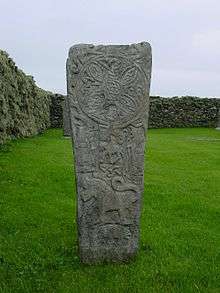Ann Naddodsdóttir
Ann Naddodsdóttir (Old Norse: Ann Naddoðsdōttir, 900s) was possibly a daughter of Naddoddr, the Viking attributed with the discovery of Iceland.

Her name may appear on a gravestone outside the cemetery of a church in Bressay, Shetland. In 1864, a stone slab was found outside the cemetery, dating from the early 10th century. The slab features carved Christian crosses and decorations of Scandinavian origin on the front and back faces. It also has various lettering carved along the edges in the ogham alphabet.[1]
In 1996, Celtic historian Katherine Forsyth from Harvard University managed to decipher the text as part of her Ph.D. dissertation.[2]
One text says[3]
- "᚛ᚉᚏᚏᚑᚄᚄᚉᚉ᚜ –– meaning: CRRO[S]SCC (gaelic for "cross")[4]
- "᚛ᚅᚐᚆᚆᚈᚃᚃᚇᚇᚐᚇᚇᚄ᚜" meaning NAHHTVVDDA[DD]S
- "᚛ᚇᚐᚈᚈᚏᚏ᚜" meaning DATTRR (Norse for "daughter")[4]
- "᚛ᚐᚅᚅ" meaning [A]NN [--]
And the other says:
- " ᚁᚓᚅᚔᚄᚓᚄ ᚋᚓᚊᚊ ᚇᚇᚏᚑᚐᚅᚅ᚜" meaning BEN[I]SES MEQQ DDR[O]ANN (MEQQ is Gaelic for "Mac", son-of)[4]
It mentions the following names: Nahhtvdda[dd]s, Ben[i]ses, Ddr[o]ann
- See Ogham inscriptions
According to Dr. Forsyth[2] (and other previous scientists) it can be translate in Old Norwegian to: "HER: KROSSUR: NADDODDSDÓTTIR: ANN" and: "(AV) BEINIR SONUR DRÓIN"
Descendant theory
Forsyth says[2] that this Ann Naddodsdóttir was a Faroese Viking. The son Beinir Dróinsson (MacDroan) who raised the grave might be identical to Beinir Sigmundsson who according to Færeyinga saga was the brother of Brestir Sigmundsson who together ruled their own half of the Faroe Islands. They both died in 970. Brestir's son Sigmundur Brestisson apparently introduced Christianity to the Faroe Islands in 999. If this is true Sigmundur was already of Christian faith at birth.
References
- Cross Slab (Early Medieval), Ogham Inscribed Stone (Early Medieval) at canmore.org.uk, last accessed on Nov 27, 2017.
- Katherine S. Forsyth: The Ogham Inscriptions of Scotland. An Edited Corpus. Harvard University Dissertation, Cambridge, Mass. 1996
- Katherine Holman. "BREAY/1". Celtic Inscribed Stones Project. University College London.
- Scandinavian runic inscriptions in the British Isles. Tapir (Trondheim, Norway). 1996. p. 280Ph.D. Dissertation at Nottingham University